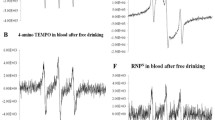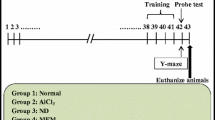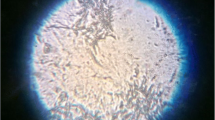Abstract
Alzheimer’s disease (AD) is characterized by amyloid (A)β peptide accumulation and intracellular neurofibrillary tangles. New hypotheses have suggested that AD involves neuroinflammation and oxidative stress. Gold nanoparticles (AuNP) presents anti-inflammatory and antioxidant characteristics. The present study evaluated the AuNP treatment on an AD model (okadaic acid, OA). Male Wistar rats were injected intracerebroventricularly with OA (100 μg); 24 h later they were treated with 20-nm AuNP (at a dose 2.5 mg/kg) every 48 h for 21 days. The following groups were separated (n = 12/group): Sham, AuNP, OA, and OA + AuNP. OA increases Tau phosphorylation in the cortex and hippocampus, while AuNP treatment maintained it as normal. Spatial memory was impaired by OA, and AuNP treatment prevented this deficit. Neurotrophic factors (BDNF and NGF- β) in the cortex and hippocampus were decreased by OA. The OA and OA + AuNP groups showed increased interleukin (IL)-1 β in the hippocampus and cortex, and the AuNP group showed increased IL-1 β in the hippocampus. In both groups, S100 levels in the cortex and hippocampus were increased by OA. IL-4 was increased in OA + AuNP animals. AuNPs prevented oxidative stress (sulfhydryl and nitrite levels) in brain structures induced by OA. Moreover, OA modulated ATP synthase activity, and AuNP maintained normal brain mitochondrial function. The antioxidant capacities were reduced by OA, and AuNP restored antioxidant status (SOD, catalase activities and GSH levels) on brain. OA-induced damage on brain tissues, and long-term AuNP treatment prevented the neuroinflammation, modulation of mitochondrial function, and impaired cognition induced by AD model, showing that AuNPs may be a promising treatment for neurodisease caused by these elements.





Similar content being viewed by others
References
Lane CA, Hardy J, Schott JM (2018) Alzheimer’s disease. Eur J Neurol 25(1):59–70. https://doi.org/10.1111/ene.13439
Serrano-Pozo A, Frosch MP, Masliah E, Hyman BT (2011) Neuropathological alterations in Alzheimer disease. Cold Spring Harb Perspect Med 1(1):a006189. https://doi.org/10.1101/cshperspect.a006189
Villemagne VL, Dore V, Burnham SC, Masters CL, Rowe CC (2018) Imaging tau and amyloid-beta proteinopathies in Alzheimer disease and other conditions. Nat Rev Neurol 14(4):225–236. https://doi.org/10.1038/nrneurol.2018.9
Nazem A, Sankowski R, Bacher M, Al-Abed Y (2015) Rodent models of neuroinflammation for Alzheimer’s disease. J Neuroinflammation 12:74. https://doi.org/10.1186/s12974-015-0291-y
Crutcher KA, Gendelman HE, Kipnis J, Perez-Polo JR, Perry VH, Popovich PG, Weaver LC (2006) Debate: "is increasing neuroinflammation beneficial for neural repair?". J Neuroimmune Pharmacol 1 (3):195–211. doi:https://doi.org/10.1007/s11481-006-9021-7
Ferreira ST, Clarke JR, Bomfim TR, De Felice FG (2014) Inflammation, defective insulin signaling, and neuronal dysfunction in Alzheimer’s disease. Alzheimers Demen 10(1 Suppl):S76–S83. https://doi.org/10.1016/j.jalz.2013.12.010
Chaves ML, Camozzato AL, Ferreira ED, Piazenski I, Kochhann R, Dall’Igna O, Mazzini GS, Souza DO et al (2010) Serum levels of S100B and NSE proteins in Alzheimer’s disease patients. J Neuroinflammation 7:6. https://doi.org/10.1186/1742-2094-7-6
Deng S, Ai Y, Gong H, Feng Q, Li X, Chen C, Liu Z, Wang Y et al (2018) Mitochondrial dynamics and protective effects of a mitochondrial division inhibitor, Mdivi-1, in lipopolysaccharide-induced brain damage. Biochem Biophys Res Commun 496(3):865–871. https://doi.org/10.1016/j.bbrc.2018.01.136
Muller AP, Haas CB, Camacho-Pereira J, Brochier AW, Gnoatto J, Zimmer ER, de Souza DO, Galina A et al (2013) Insulin prevents mitochondrial generation of H(2)O(2) in rat brain. Exp Neurol 247:66–72. https://doi.org/10.1016/j.expneurol.2013.03.007
Cai Q, Tammineni P (2017) Mitochondrial aspects of synaptic dysfunction in Alzheimer’s disease. J Alzheimers Dis 57(4):1087–1103. https://doi.org/10.3233/JAD-160726
Song GJ, Suk K (2017) Pharmacological modulation of functional phenotypes of microglia in neurodegenerative diseases. Front Aging Neurosci 9:139. https://doi.org/10.3389/fnagi.2017.00139
Goedert M (1993) Tau protein and the neurofibrillary pathology of Alzheimer’s disease. Trends Neurosci 16(11):460–465
Yang Y, Wang JZ (2018) Nature of tau-associated neurodegeneration and the molecular mechanisms. J Alzheimers Dis 62(3):1305–1317. https://doi.org/10.3233/JAD-170788
Iqbal K, Liu F, Gong CX, Alonso Adel C, Grundke-Iqbal I (2009) Mechanisms of tau-induced neurodegeneration. Acta Neuropathol 118(1):53–69. https://doi.org/10.1007/s00401-009-0486-3
Beharry C, Cohen LS, Di J, Ibrahim K, Briffa-Mirabella S, Alonso Adel C (2014) Tau-induced neurodegeneration: mechanisms and targets. Neurosci Bull 30(2):346–358. https://doi.org/10.1007/s12264-013-1414-z
Danysz W, Parsons CG (2012) Alzheimer’s disease, beta-amyloid, glutamate, NMDA receptors and memantine - searching for the connections. Brit J Pharmacol 167(2):324–352. https://doi.org/10.1111/j.1476-5381.2012.02057.x
Zhang Z, Simpkins JW (2010) An okadaic acid-induced model of tauopathy and cognitive deficiency. Brain Res 1359:233–246. https://doi.org/10.1016/j.brainres.2010.08.077
Kamat PK, Rai S, Swarnkar S, Shukla R, Nath C (2014) Molecular and cellular mechanism of okadaic acid (OKA)-induced neurotoxicity: a novel tool for Alzheimer’s disease therapeutic application. Mol Neurobiol 50(3):852–865. https://doi.org/10.1007/s12035-014-8699-4
Paula MM, Petronilho F, Vuolo F, Ferreira GK, De Costa L, Santos GP, Effting PS, Dal-Pizzol F et al (2015) Gold nanoparticles and/or N-acetylcysteine mediate carrageenan-induced inflammation and oxidative stress in a concentration-dependent manner. J Biomed Mater Res A 103(10):3323–3330. https://doi.org/10.1002/jbm.a.35469
Larsen A, Kolind K, Pedersen DS, Doering P, Pedersen MO, Danscher G, Penkowa M, Stoltenberg M (2008) Gold ions bio-released from metallic gold particles reduce inflammation and apoptosis and increase the regenerative responses in focal brain injury. Histochem Cell Biol 130(4):681–692. https://doi.org/10.1007/s00418-008-0448-1
Pedersen MO, Larsen A, Pedersen DS, Stoltenberg M, Penkowa M (2009) Metallic gold treatment reduces proliferation of inflammatory cells, increases expression of VEGF and FGF, and stimulates cell proliferation in the subventricular zone following experimental traumatic brain injury. Histol Histopathol 24(5):573–586. https://doi.org/10.14670/HH-24.573
Yang JP, Merin JP, Nakano T, Kato T, Kitade Y, Okamoto T (1995) Inhibition of the DNA-binding activity of NF-kappa B by gold compounds in vitro. FEBS Lett 361(1):89–96
Chircorian A, Barrios AM (2004) Inhibition of lysosomal cysteine proteases by chrysotherapeutic compounds: a possible mechanism for the antiarthritic activity of Au(I). Bioorg Med Chem Lett 14(20):5113–5116. https://doi.org/10.1016/j.bmcl.2004.07.073
Han S, Kim K, Kim H, Kwon J, Lee YH, Lee CK, Song Y, Lee SJ et al (2008) Auranofin inhibits overproduction of pro-inflammatory cytokines, cyclooxygenase expression and PGE2 production in macrophages. Arch Pharm Res 31(1):67–74
Tsai CY, Shiau AL, Chen SY, Chen YH, Cheng PC, Chang MY, Chen DH, Chou CH et al (2007) Amelioration of collagen-induced arthritis in rats by nanogold. Arthritis Rheum 56(2):544–554. https://doi.org/10.1002/art.22401
Barathmanikanth S, Kalishwaralal K, Sriram M, Pandian SR, Youn HS, Eom S, Gurunathan S (2010) Anti-oxidant effect of gold nanoparticles restrains hyperglycemic conditions in diabetic mice. J Nanobiotechnol 8:16. https://doi.org/10.1186/1477-3155-8-16
Sul OJ, Kim JC, Kyung TW, Kim HJ, Kim YY, Kim SH, Kim JS, Choi HS (2010) Gold nanoparticles inhibited the receptor activator of nuclear factor-kappab ligand (RANKL)-induced osteoclast formation by acting as an antioxidant. Biosci Biotechnol Biochem 74(11):2209–2213. https://doi.org/10.1271/bbb.100375
Muller AP, Ferreira GK, da Silva S, Nesi RT, de Bem Silveira G, Mendes C, Pinho RA, da Silva Paula MM et al (2017) Safety protocol for the gold nanoparticles administration in rats. Mater Sci Eng C Mater Biol Appl 77:1145–1150. https://doi.org/10.1016/j.msec.2017.04.027
Cho WS, Chae C (2004) Expression of cyclooxygenase-2 and nitric oxide synthase 2 in swine ulcerative colitis caused by Salmonella typhimurium. Vet Pathol 41(4):419–423. https://doi.org/10.1354/vp.41-4-419
Ellman GL (1959) Tissue sulfhydryl groups. Arch Biochem Biophys 82(1):70–77
Bannister JV, Calabrese L (1987) Assays for superoxide dismutase. Methods Biochem Anal 32:279–312
Aebi H (1984) Catalase in vitro. Methods Enzymol 105:121–126
Hissin PJ, Hilf R (1976) A fluorometric method for determination of oxidized and reduced glutathione in tissues. Anal Biochem 74(1):214–226
Lowry OH, Rosebrough NJ, Farr AL, Randall RJ (1951) Protein measurement with the Folin phenol reagent. J Biol Chem 193(1):265–275
Donohue MC, Sperling RA, Salmon DP, Rentz DM, Raman R, Thomas RG, Weiner M, Aisen PS (2014) The preclinical Alzheimer cognitive composite measuring amyloid-related decline. Jama Neurol 71(8):961–970. https://doi.org/10.1001/jamaneurol.2014.803
Spires-Jones TL, Hyman BT (2014) The intersection of amyloid Beta and Tau at synapses in Alzheimer’s disease. Neuron 82(4):756–771. https://doi.org/10.1016/j.neuron.2014.05.004
Rajasekar N, Dwivedi S, Tota SK, Kamat PK, Hanif K, Nath C, Shukla R (2013) Neuroprotective effect of curcumin on okadaic acid induced memory impairment in mice. Eur J Pharmacol 715(1–3):381–394. https://doi.org/10.1016/j.ejphar.2013.04.033
Kamat PK, Tota S, Rai S, Swarnkar S, Shukla R, Nath C (2012) A study on neuroinflammatory marker in brain areas of okadaic acid (ICV) induced memory impaired rats. Life Sci 90(19–20):713–720. https://doi.org/10.1016/j.lfs.2012.03.012
Bahamonde J, Brenseke B, Chan MY, Kent RD, Vikesland PJ, Prater MR (2018) Gold nanoparticle toxicity in mice and rats: Species differences. Toxicol Pathol 46(4):431–443. https://doi.org/10.1177/0192623318770608
Muller AP, Ferreira GK, Pires AJ, de Bem Silveira G, de Souza DL, Brandolfi JA, de Souza CT, Paula MMS et al (2017) Gold nanoparticles prevent cognitive deficits, oxidative stress and inflammation in a rat model of sporadic dementia of Alzheimer’s type. Mater Sci Eng C Mater Biol Appl 77:476–483. https://doi.org/10.1016/j.msec.2017.03.283
Takeuchi I, Nobata S, Oiri N, Tomoda K, Makino K (2017) Biodistribution and excretion of colloidal gold nanoparticles after intravenous injection: effects of particle size. Biomed Mater Eng 28(3):315–323. https://doi.org/10.3233/BME-171677
Hampel H, Vergallo A, Aguilar LF, Benda N, Broich K, Cuello AC, Cummings J, Dubois B, Federoff HJ, Fiandaca M, Genthon R, Haberkamp M, Karran E, Mapstone M, Perry G, Schneider LS, Welikovitch LA, Woodcock J, Baldacci F, Lista S, Apmi (2018) Precision pharmacology for Alzheimer’s disease. Pharmacological research 130:331–365. https://doi.org/10.1016/j.phrs.2018.02.014
Hall JM, Gomez-Pinilla F, Savage LM (2018) Nerve growth factor is responsible for exercise-induced recovery of septohippocampal cholinergic structure and function. Front Neurosci-Switz 12. https://doi.org/10.3389/Fnins.2018.00773
von Bohlen Und Halbach O, von Bohlen Und Halbach V (2018) BDNF effects on dendritic spine morphology and hippocampal function. Cell Tissue Res 373 (3):729–741. doi:https://doi.org/10.1007/s00441-017-2782-x
Atasoy IL, Dursun E, Gezen-Ak D, Metin-Armagan D, Ozturk M, Yilmazer S (2017) Both secreted and the cellular levels of BDNF attenuated due to tau hyperphosphorylation in primary cultures of cortical neurons. J Chem Neuroanat 80:19–26. https://doi.org/10.1016/j.jchemneu.2016.11.007
Meraz-Rios MA, Toral-Rios D, Franco-Bocanegra D, Villeda-Hernandez J, Campos-Pena V (2013) Inflammatory process in Alzheimer’s disease. Front Integr Neurosci 7:59. https://doi.org/10.3389/fnint.2013.00059
Rostami F, Javan M, Moghimi A, Haddad-Mashadrizeh A, Fereidoni M (2017) Streptozotocin-induced hippocampal astrogliosis and insulin signaling malfunction as experimental scales for subclinical sporadic Alzheimer model. Life Sci 188:172–185. https://doi.org/10.1016/j.lfs.2017.08.025
Bright F, Werry EL, Dobson-Stone C, Piguet O, Ittner LM, Halliday GM, Hodges JR, Kiernan MC et al (2019) Neuroinflammation in frontotemporal dementia. Nat Rev Neurol 15:540–555. https://doi.org/10.1038/s41582-019-0231-z
Ransohoff RM (2016) A polarizing question: do M1 and M2 microglia exist? Nat Neurosci 19(8):987–991. https://doi.org/10.1038/nn.4338
Takemiya T, Fumizawa K, Yamagata K, Iwakura Y, Kawakami M (2017) Brain Interleukin-1 facilitates learning of a water maze spatial memory task in young mice. Front Behav Neurosci 11:202. https://doi.org/10.3389/fnbeh.2017.00202
Casella G, Garzetti L, Gatta AT, Finardi A, Maiorino C, Ruffini F, Martino G, Muzio L et al (2016) IL4 induces IL6-producing M2 macrophages associated to inhibition of neuroinflammation in vitro and in vivo. J Neuroinflammation 13(1):139. https://doi.org/10.1186/s12974-016-0596-5
Lai TH, Chung CH, Chen BH, Hung CF, Inbaraj BS, Ma MC, Chen HM, Tsou CJ et al (2016) Gold nanoparticles compromise TNF-alpha-induced endothelial cell adhesion molecule expression through NF-kappaB and protein degradation pathways and reduce neointima formation in a rat carotid balloon injury model. J Biomed Nanotechnol 12(12):2185–2101
Pereira DV, Petronilho F, Pereira HR, Vuolo F, Mina F, Possato JC, Vitto MF, de Souza DR et al (2012) Effects of gold nanoparticles on endotoxin-induced uveitis in rats. Invest Ophthalmol Vis Sci 53(13):8036–8041. https://doi.org/10.1167/iovs.12-10743
Sumbayev VV, Yasinska IM, Garcia CP, Gilliland D, Lall GS, Gibbs BF, Bonsall DR, Varani L et al (2013) Gold nanoparticles downregulate Interleukin-1-induced pro-inflammatory responses. Small 9(3):472–477. https://doi.org/10.1002/smll.201201528
Giannakopoulou A, Lyras GA, Grigoriadis N (2017) Long-term effects of autoimmune CNS inflammation on adult hippocampal neurogenesis. J Neurosci Res 95(7):1446–1458. https://doi.org/10.1002/jnr.23982
Cirillo C, Capoccia E, Iuvone T, Cuomo R, Sarnelli G, Steardo L, Esposito G (2015) S100B inhibitor pentamidine attenuates reactive gliosis and reduces neuronal loss in a mouse model of Alzheimer’s disease. Biomed Res Int 2015:1–11. https://doi.org/10.1155/2015/508342
Tonnies E, Trushina E (2017) Oxidative stress, synaptic dysfunction, and Alzheimer’s disease. J Alzheimers Dis 57(4):1105–1121. https://doi.org/10.3233/JAD-161088
Yin F, Sancheti H, Patil I, Cadenas E (2016) Energy metabolism and inflammation in brain aging and Alzheimer’s disease. Free Radical Bio Med 100:108–122. https://doi.org/10.1016/j.freeradbiomed.2016.04.200
Chen H, Dorrigan A, Saad S, Hare DJ, Cortie MB, Valenzuela SM (2013) In vivo study of spherical gold nanoparticles: inflammatory effects and distribution in mice. PLoS One 8(2):e58208. https://doi.org/10.1371/journal.pone.0058208
Cho MH, Kim DH, Choi JE, Chang EJ, Seung Y (2012) Increased phosphorylation of dynamin-related protein 1 and mitochondrial fission in okadaic acid-treated neurons. Brain Res 1454:100–110. https://doi.org/10.1016/j.brainres.2012.03.010
Yakimovich T, Lemaire ED, Kofman J (2009) Engineering design review of stance-control knee-ankle-foot orthoses. J Rehabil Res Dev 46(2):257–267
Zhou YT, He W, Wamer WG, Hu X, Wu X, Lo YM, Yin JJ (2013) Enzyme-mimetic effects of gold@platinum nanorods on the antioxidant activity of ascorbic acid. Nanoscale 5(4):1583–1591. https://doi.org/10.1039/c2nr33072e
Yakimovich NO, Ezhevskii AA, Guseinov DV, Smirnova LA, Gracheva TA, Klychkov KS (2008) Antioxidant properties of gold nanoparticles studied by ESR spectroscopy. Russ Chem B+ 57(3):520–523. https://doi.org/10.1007/s11172-008-0080-1
Kirdaite G, Leonaviciene L, Bradunaite R, Vasiliauskas A, Rudys R, Ramanaviciene A, Mackiewicz Z (2019) Antioxidant effects of gold nanoparticles on early stage of collagen-induced arthritis in rats. Res Vet Sci 124:32–37. https://doi.org/10.1016/j.rvsc.2019.02.002
Rizwan H, Mohanta J, Si S, Pal A (2017) Gold nanoparticles reduce high glucose-induced oxidative-nitrosative stress regulated inflammation and apoptosis via tuberin-mTOR/NF-kappaB pathways in macrophages. Int J Nanomedicine 12:5841–5862. https://doi.org/10.2147/IJN.S141839
Silveira PC, Victor EG, Notoya Fde S, Scheffer Dda L, Silva L, Cantu RB, Martinez VH, de Pinho RA et al (2016) Effects of phonophoresis with gold nanoparticles on oxidative stress parameters in a traumatic muscle injury model. Drug delivery 23(3):926–932. https://doi.org/10.3109/10717544.2014.923063
Huang X, El-Sayed IH, Yi X, El-Sayed MA (2005) Gold nanoparticles: catalyst for the oxidation of NADH to NAD. J Photochem Photobiol B 81(2):76–83. https://doi.org/10.1016/j.jphotobiol.2005.05.010
Goldstein A, Soroka Y, Frusic-Zlotkin M, Lewis A, Kohen R (2016) The bright side of plasmonic gold nanoparticles; activation of Nrf2, the cellular protective pathway. Nanoscale 8(22):11748–11759. https://doi.org/10.1039/c6nr02113a
Lai TH, Shieh JM, Tsou CJ, Wu WB (2015) Gold nanoparticles induce heme oxygenase-1 expression through Nrf2 activation and Bach1 export in human vascular endothelial cells. Int J Nanomedicine 10:5925–5939. https://doi.org/10.2147/Ijn.S88514
Manna K, Mishra S, Saha M, Mahapatra S, Saha C, Yenge G, Gaikwad N, Pal R et al (2019) Amelioration of diabetic nephropathy using pomegranate peel extract-stabilized gold nanoparticles: assessment of NF-kappa B and Nrf2 signaling system. Int J Nanomedicine 14:1753–1777. https://doi.org/10.2147/Ijn.S176013
Funding
This work was supported by FAPESC-PPSUS 2016, CNPq, Instituto Nacional de Neurociência Translacional-INNT #465346/2014-6, and Unesc.
Author information
Authors and Affiliations
Corresponding author
Ethics declarations
Conflict of Interest
The authors declare that they have no conflict of interest.
Additional information
Publisher’s Note
Springer Nature remains neutral with regard to jurisdictional claims in published maps and institutional affiliations.
Electronic supplementary material
ESM 1
(DOCX 18 kb)
Rights and permissions
About this article
Cite this article
dos Santos Tramontin, N., da Silva, S., Arruda, R. et al. Gold Nanoparticles Treatment Reverses Brain Damage in Alzheimer’s Disease Model. Mol Neurobiol 57, 926–936 (2020). https://doi.org/10.1007/s12035-019-01780-w
Received:
Accepted:
Published:
Issue Date:
DOI: https://doi.org/10.1007/s12035-019-01780-w




